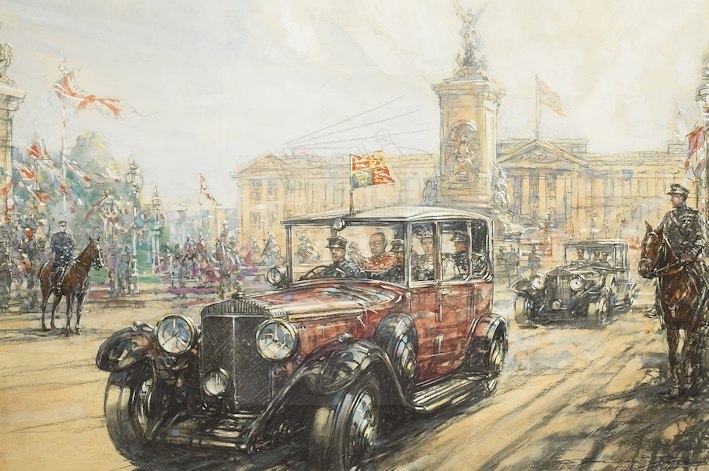By Robert Tate, Automotive Historian and Researcher
Images from the worldwide web
Published 11.21.2018
 Frederick Gordon Crosby in his art studio
Frederick Gordon Crosby in his art studio
This is a story about Frederick Gordon Crosby (1885-1943), an English automotive illustrator who created great works of art. I have always been a great fan of Crosby's artwork, and he still has many fans worldwide. From sporty race cars to stylish vehicles from the past, Crosby created beautiful illustrations of early automobile scenes. Whether working with pen and ink, charcoal, gouache or oils, he was one of the best.
At the beginning of his career, Crosby had no formal art training. He was mostly self-taught and had only attended classes for drawing life figures only. However, his teachers knew early on that Crosby had a very rare and exceptional talent.
 Two vintage race cars
Two vintage race cars
In 1908, at the age of 28, he started working as a draftsman at the Daimler Motor Company. As his career continued, he would illustrate great works of automotive art for Auto-Car magazine. Automotive historians have said that “he had worked at the beginning of the automotive era and matured with the industry.”

Crosby was a great engineer and draftsman, and this allowed him to be technically accurate and creative when it came to the automotive form. Some of his color paintings were done in special portfolios called “The Endless Quest for Speed.”

Most of Crosby’s artwork were illustrations for Auto-Car magazine, a publication that saw its greatest heights in the 1920s and 1930s, according to automotive historians. Crosby’s work was different in style and media, documenting his emerging style. Some of his work would become emblematic of his time.

Crosby, throughout his career, had received opportunities for illustrating great works of art. For example, he was commissioned to produce several paintings of the Targa Florio race track in Sicily, highlighting full-color caricatures of the foremost racers of the day with their popular race cars. He also worked on a great number of plaques, sculptures and medallions of motoring subjects that everyone admired. Crosby would later create and design the Jaguar “leaping cat” mascot, which first appeared on Jaguar models in 1938. It should also be noted that, during the Second World War, Crosby illustrated some of his best work, especially the “Roads of War” series, along with his great illustrations of the war at sea and in the air.

In later years, Crosby was sometimes approached by customers to illustrate works of art to be sold or auctioned to raise money for various charities, such as for the Barnardos in 1933-1934 with a French Alps scene or a painting called Aeroplane Diving commissioned by King George VI for the Royal Air Force Benevolent Fund. Crosby also had several great exhibitions during his lifetime featuring many of his greatest works, including three exhibits at the Royal Academy starting in 1916.
 An MG from the 1930s
An MG from the 1930s
In conclusion, Crosby did not graduate from any art school or receive any sort of formal training but started his career as an engineer and draftsman at Daimler. For many years, he had created great works of art that people still admire today. He emphasized powerful automotive machines with big long hoods, heroic drivers and would occasionally include onlookers to focus attention. He helped us remember defining moments in our automotive history, including dramatic sporting events and great looking automobiles that will not be forgotten.
Bibliography
Garner, Peter. “The Art of Gordon Crosby.” 1978.



